Experiences in Developing a Decision Support Tool for Agricultural Decision-Makers—Australian CliMate
Abstract
1. Introduction
2. Design Philosophy
2.1. Conceptual Framework
- Assessing the current condition of a system (rainfall to date, soil water, heat sum, and drought) using near real-time data from a local weather station, the “knowable” element shown in Figure 2.
- Probability of future weather events based on “climatology” derived from a probabilistic analysis of historic weather data (rainfall, temperature, and radiation) and derivatives (heat sum and soil moisture).
2.2. Specifications
- Develop a common interface between the previously valued but lapsed analyses.
- Support transparent and open-ended queries to accommodate users’ rules and models across a wide range of agricultural production systems (grazing, cropping, horticulture, and apiculture).
- Involve stakeholders early in development and revise prototypes based on feedback.
- Aim for a minimalist interface (input and output), applying a principle of “if in doubt, leave it out”, and use easily recognised graphical presentations such as “fire risk” charts, histograms, and line graphs.
- Provide output as text and graphics to accommodate different learning styles [25];
- Enable mobile device apps to be used “offline” by farmers when in the “field”. This required accessing and storing climate data sourced when last connected to the internet.
- Include a “backend” to support iterative tuning of interfaces based on user feedback, shortening development cycles.
- Embed the ability to monitor use of each analysis, including spatial and industry applications.
| Analysis Origin 1 | Function and Application (Variables 2) | Interface |
|---|---|---|
| How’s the season? Rainman [3,4] Qld Govt. | Current season relative to long term. Adjust expectations and inputs. (1, 2, 4, 5) | 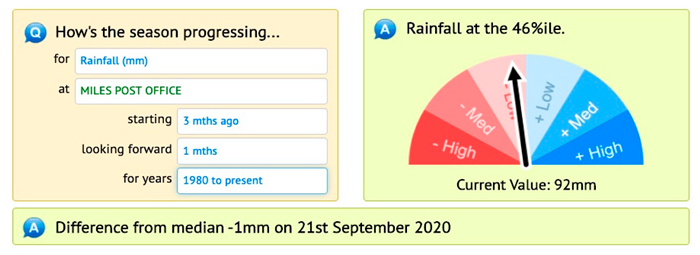 |
| How often? Howoften? [18] Qld Govt. | Probability of weather events. Risk assessment key operations, e.g., planting, rain, heat/frost stress, and grazing days. (1, 2, 4) | 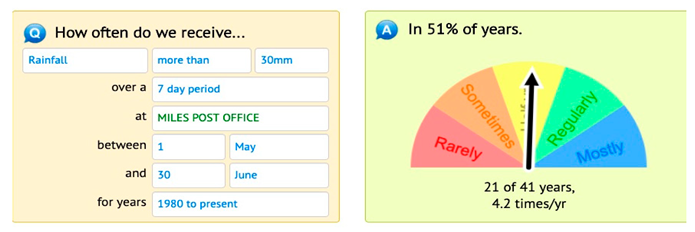 |
| How Wet/Nitrate? Howwet? [5] Qld Govt. | Soil water and nitrate accumulation in fallows. Yield expectations, nitrogen inputs, and crop choice (1, 2, 6, 7) | 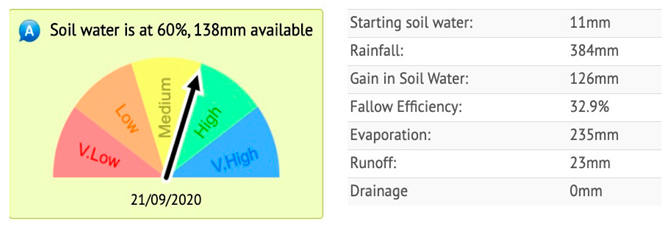 |
| Potential yield? WUE [28] PYCalc [29], DAWA | Expected crop yield. Adjust inputs and marketing. (1, 8, WUE) |  |
| Drought? SCOPIC [30,31] Qld Govt. | Drought status, rainfall deficit, and decile method. Stocking rate alert and financial relief (1, 9) | 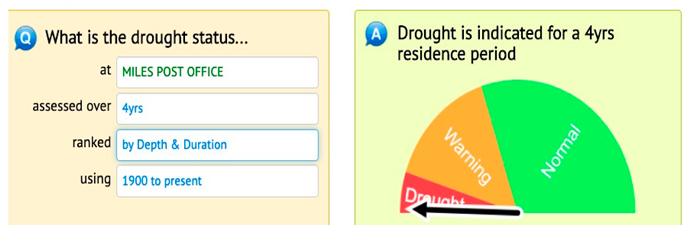 |
| How hot/cold? CropMate [6] NSW Govt. | Coincident probability of min. and max. temperature. Risk assessment for new crops and new managers (1, 2) | 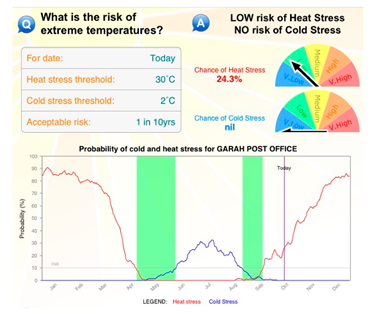 |
| How’s the past? Standard statistics. MCVP | Historic weather. Seasonal overview. Land purchase (1, 2, 3, 4) | 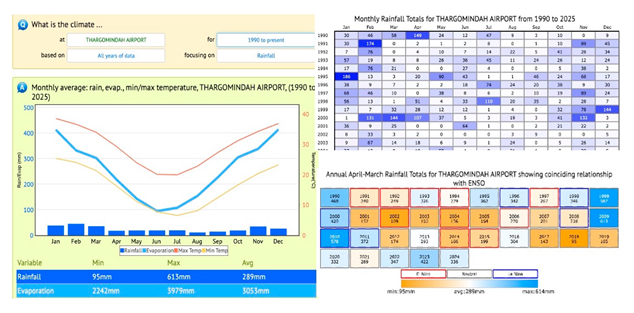 |
| What trend? Graphical analysis MCVP | Long-term trend graphics. Assess trends and variability (1, 2, 4, 10) | 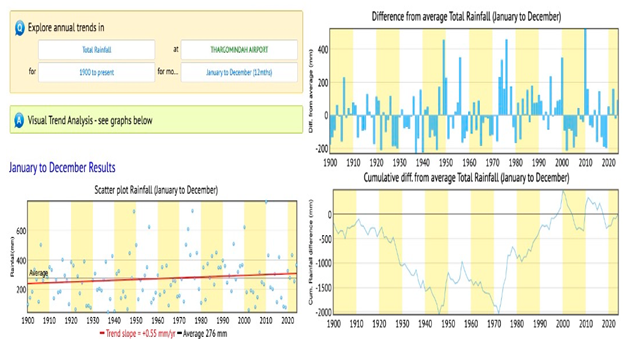 |
| How likely? SCOPIC [30] BoM, Qld Govt. | Season forecast and skill (ENSO). Assess forecast skill to complement “climatology” assessment (11) | 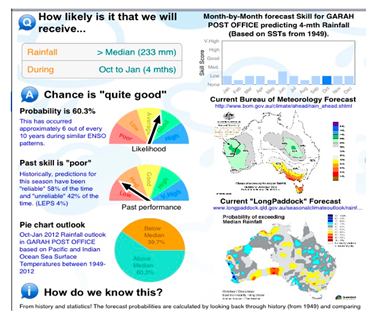 |
| How’s El Nino Direct lookup BoM, Qld Govt., MCVP | SOI and ENSO status. Seasonal forecast (11) | 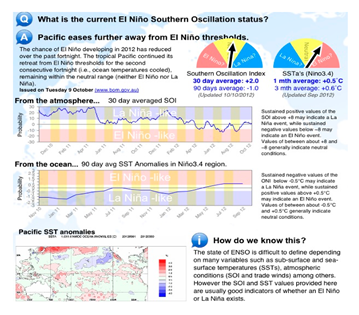 |
2.3. Software and Data Sources
2.4. Ethical Considerations
3. The Analyses
4. Adoption
5. Discussion
Lessons Learnt
- DST development requires a partnership between the intended audience, a program manager, a software engineer, and a connection to people with empathy and knowledge of the audience and technical issues.
- If software development were to be contracted, specifications would need to be very tight. In this case, an organic development cycle allowed for synergy between software design, interface design, and user feedback. CliMate’s specification at project initiation would have been difficult, as the development team did not understand user preferences without a prototype, and the designers did not fully understand software and technology capabilities and limitations.
- There is a strong tendency for a DST to be comprehensive yet flexible—potentially leading to added complexity and reduced useability [16]. “Keep it simple, stupid” (KISS) is a hard but essential lesson in building a useful DST.
- Multiple platforms (iOS, Android, and www) increased costs and time to develop. An option might be to develop a rapid www-based prototype, interact with a sample of prospective users, and carry out an initial evaluation.
- DSTs may have simple interfaces, but technology requires maintenance and ongoing support (servers, etc.), which needs to be budgeted over the expected life of a DST.
- Technical problems in software development are inevitable as technologies and third-party data sources evolve, requiring continual support for the expected life of each DST. It seems that 10 years is an over-optimistic life expectancy for a DST.
- DSTs require promotion, evaluation, and maintenance after release. Investors underappreciate the importance of building on an initial investment, especially if early indications of acceptance and use are available.
- Evaluation is important to justify an initial investment and guide future development. CliMate was independently evaluated in 2018 [38], but there was no scope to act on findings.
6. Conclusions
Supplementary Materials
Author Contributions
Funding
Data Availability Statement
Acknowledgments
Conflicts of Interest
References
- Nicholls, N.; Drosdowsky, W.; Lavery, B. Australian rainfall variability and change. Weather 1996, 52, 66–72. [Google Scholar] [CrossRef]
- Felton, W.L.; Freebairn, D.M.; Fettell, N.A.; Thomas, J.B. Crop residue management. In Tillage: New Directions in Australian Agriculture; Cornish, P.S., Pratley, J.E., Eds.; Australian Society of Agronomy, Inkata Press: Melbourne, Australia, 1987; Chapter 7; pp. 171–193. Available online: https://www.agronomyaustraliaproceedings.org/images/sampledata/Tillage/7.%20Chapter%207.pdf (accessed on 25 June 2025).
- Hughes, N.; Galeano, D.; Hatfield-Dodds, S. The Effects of Drought and Climate Variability on Australian Farms. Available online: https://www.agriculture.gov.au/abares/products/insights/effects-of-drought-and-climate-variability-on-Australian-farms (accessed on 8 September 2025).
- Clewett, J.F. Australian RAINMAN: Further Development and Application to Improve Management of Climate Variability; Publication No. 04/181; Rural Industries Research and Development Corporation: Canberra, Australia, 2005; ISBN 1741510902. [Google Scholar]
- Freebairn, D.M.; Hamilton, A.H.; Cox, P.G.; Holzworth, D. HOW WET? Estimating the Storage of Water in Your Soil Using Rainfall Records; Agricultural Production Systems Research Unit: Toowoomba, Australia, 1994. [Google Scholar]
- Grains Research and Development Corporation (GRDC). DAN00102—CropMate—Climate Information for Crop Production. 2015. Available online: https://grdc.com.au/research/projects/project?id=468 (accessed on 12 June 2025).
- Aker, J.C.; Ksoll, C. Can mobile phones improve agricultural outcomes? Evidence from a randomized experiment in Niger. Food Policy 2016, 60, 44–51. [Google Scholar] [CrossRef]
- Hamilton, W.D.; Woodruff, D.R.; Jamieson, A.M. Role of computer-based decision aids in farm decision making and in agricultural extension. In Climatic Risk in Crop Production: Models and Management for the Semiarid Tropics and Subtropics; Muchow, R.C., Bellamy, J.A., Eds.; CAB International: Wallingford, UK, 1991; pp. 453–470. [Google Scholar]
- Woodruff, D.R. WHEATMAN: A decision support system for wheat management in sub-tropical Australia. Aust. J. Agric. Res. 1992, 43, 1483–1499. [Google Scholar] [CrossRef]
- Australian Government, Bureau of Meteorology. Climate Driver Update. Available online: http://www.bom.gov.au/climate/enso/ (accessed on 11 June 2025).
- Parton, K.A.; Crean, J.; Hayman, P. The value of seasonal climate forecasts for Australian agriculture. Agric. Syst. 2019, 174, 1–10. [Google Scholar] [CrossRef]
- Anderson, J.R.; Dillon, L.; Hardaker, J.B. Agricultural Decision Analysis; Iowa State University Press: Ames, IA, USA, 1977. [Google Scholar]
- Freebairn, D.M.; McClymont, D. Australian CliMate App. Available online: https://climateapp.net.au/ (accessed on 12 June 2025).
- Ward, D. The Simplicity Cycle: A Field Guide to Making Things Better Without Making Them Worse; Harper Business: New York, NY, USA, 2015. [Google Scholar]
- Lynch, T.; Gregor, S. User participation in decision support systems development: Influencing system outcomes. Eur. J. Inf. Syst. 2004, 13, 286–291. [Google Scholar] [CrossRef]
- McCown, R.L. Locating agricultural decision support systems in the troubled past and socio-technical complexity of “models for management”. Agric. Syst. 2002, 74, 11–26. [Google Scholar] [CrossRef]
- Hayman, P. Decision support systems in Australian dryland farming: A promising past, a disappointing present and uncertain future. In Proceedings of the New Directions for a Diverse Planet, 4th International Crop Science Congress, Brisbane, Australia, 26 September–1 October 2004; Available online: https://www.agronomyaustraliaproceedings.org/images/sampledata/2004/symposia/4/1/1778_haymanp.pdf (accessed on 11 September 2025).
- Glanville, S.F.; Freebairn, D.M. Howoften? A Software Tool to Examine the Probabilities of Rainfall Events; Agricultural Production Systems Research Unit: Toowoomba, Australia, 1997. [Google Scholar]
- Kuehne, G.; Llewellyn, R.; Pannell, D.J.; Wilkinson, R.; Dolling, P.; Ouzman, J.; Ewing, M. Predicting farmer uptake of new agricultural practices: A tool for research, extension and policy. Agric. Syst. 2017, 156, 115–125. [Google Scholar] [CrossRef]
- Thomas, G.A.; Titmarsh, G.W.; Freebairn, D.M.; Radford, B.J. No-tillage and conservation farming practices in grain growing areas of Queensland: A review of 40 years of development. Aust. J. Exp. Agric. 2007, 47, 887–898. [Google Scholar] [CrossRef]
- Australian Government, Bureau of Meteorology. The Predictive Ocean Atmosphere Model for Australia (POAMA). Available online: http://www.bom.gov.au/oceanography/oceantemp/GBR_POAMA.shtml (accessed on 25 June 2025).
- Australian Government, Bureau of Meteorology. Australian Community Climate Earth-System Simulator—Seasonal (ACCESS–S). Available online: http://www.bom.gov.au/climate/ahead/about/model/access.shtml (accessed on 14 June 2025).
- Australian Government, Bureau of Meteorology. MetEye—Your Eye on the Environment. Available online: http://www.bom.gov.au/australia/meteye/ (accessed on 25 June 2025).
- Weatherzone. Australian Weather. Available online: https://www.weatherzone.com.au/ (accessed on 25 June 2025).
- Dunn, R.; Dunn, K. Teaching Students Through Their Individual Learning Styles: A Practical Approach; Reston Publishing Company: Reston, VA, USA, 1978. [Google Scholar]
- Queensland Government. SILO (Scientific Information for Land Owners). Available online: https://www.longpaddock.qld.gov.au/silo/about/ (accessed on 12 June 2025).
- Jeffrey, S.J.; Carter, J.O.; Moodie, K.B.; Beswick, A.R. Using spatial interpolation to construct a comprehensive archive of Australian climate data. Environ. Model. Softw. 2001, 16, 309–330. [Google Scholar] [CrossRef]
- French, R.J.; Schultz, J.E. Water use efficiency of wheat in a Mediterranean-type environment. I. The relation between yield, water use and climate. Aust. J. Agric. Res. 1984, 35, 743–764. [Google Scholar] [CrossRef]
- Tennant, D.; Tennant, S. PYCalc—A Potential Yield Calculator, V2.1; Department of Agriculture, Western Australia: Perth, Australia, 2013.
- Pacific Meteorological Desk Partnership. Seasonal Climate Outlooks in Pacific Island Countries (SCOPIC). 2025. Available online: https://www.pacificmet.net/products-and-services/seasonal-climate-outlooks-pacific-island-countries-scopic (accessed on 14 June 2025).
- Wilks, D.S. Statistical Methods in the Atmospheric Sciences; Academic Press: San Diego, CA, USA, 1995. [Google Scholar]
- National Farmers Federation. Available online: https://nff.org.au/ (accessed on 10 June 2025).
- Australian Government, Australian Bureau of Statistics. Available online: https://www.abs.gov.au/ (accessed on 11 June 2025).
- Macadam, R.; Britton, I.; Russell, D.; Potts, W.; Baillie, B.; Shaw, A. The use of soft systems methodology to improve the adoption by Australian cotton growers of the Siratac computer-based crop management system. Agric. Syst. 1990, 34, 1–14. [Google Scholar] [CrossRef]
- Laurenson, M.; Ninomiya, S. Successful agricultural decision support systems. Agric. Inf. Res. 2002, 11, 5–25. [Google Scholar] [CrossRef][Green Version]
- Rhee, C.; Rao, H. Evaluation of decision support systems. In Handbook on Decision Support Systems 2; Burstein, F., Holsapple, C.W., Eds.; Springer: Berlin/Heidelberg, Germany, 2008; pp. 85–107. [Google Scholar] [CrossRef]
- Cox, P. Some issues in the design of agricultural decision support systems. Agric. Syst. 1996, 52, 355–381. [Google Scholar] [CrossRef]
- Starasts, A. Australian CliMate App: An Evaluation for the Managing Climate Variability Program; University of Southern Queensland: Toowoomba, Australia, 2018; Available online: https://research.usq.edu.au/download/f1ee2c47ccdd7d45e243ef0bafdb3153de6a0bd51ba7a75b2bc1a2b91de37517/4067978/Evaluation%20Australian%20Climate%20app%202018.pdf (accessed on 12 June 2025).
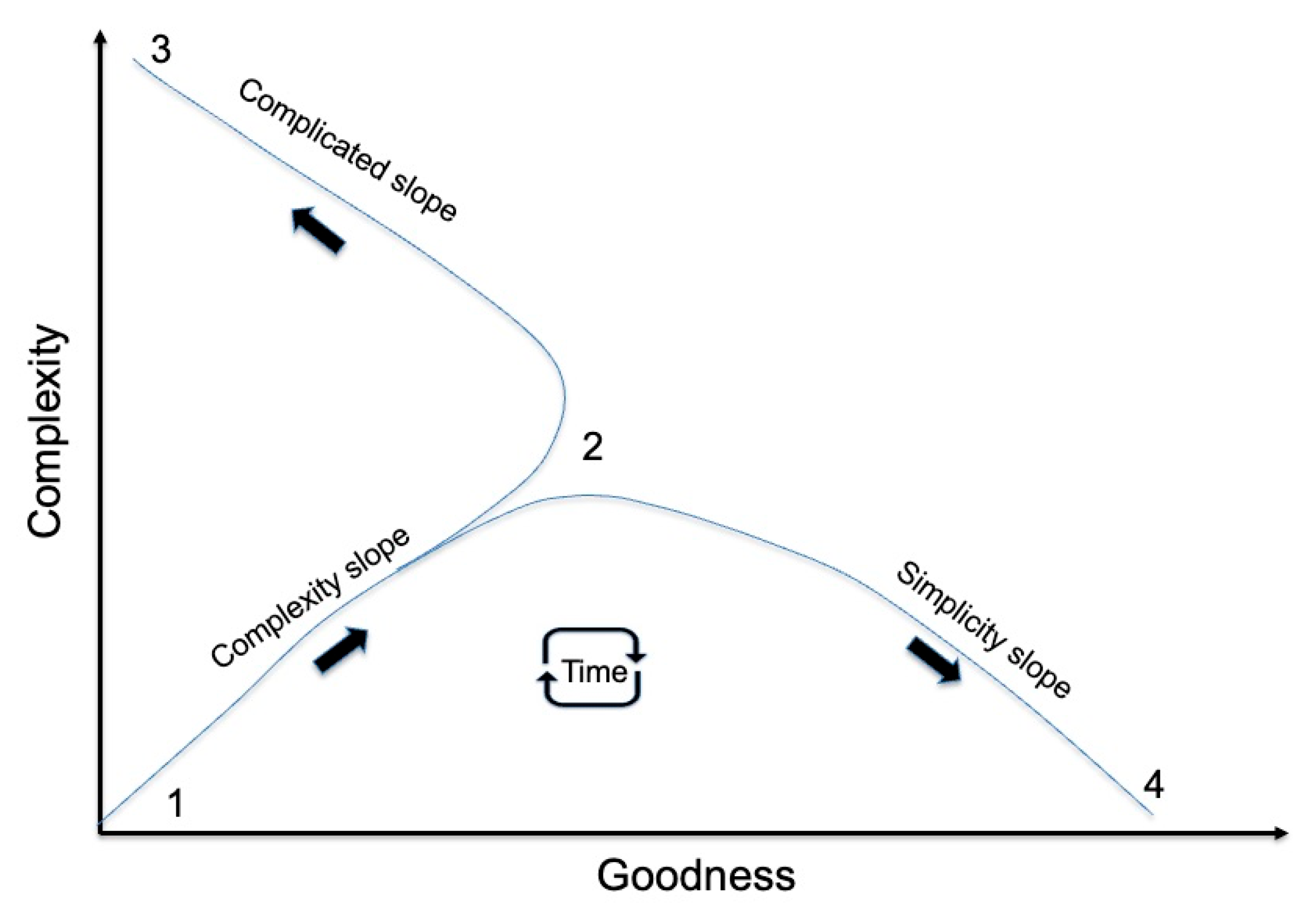
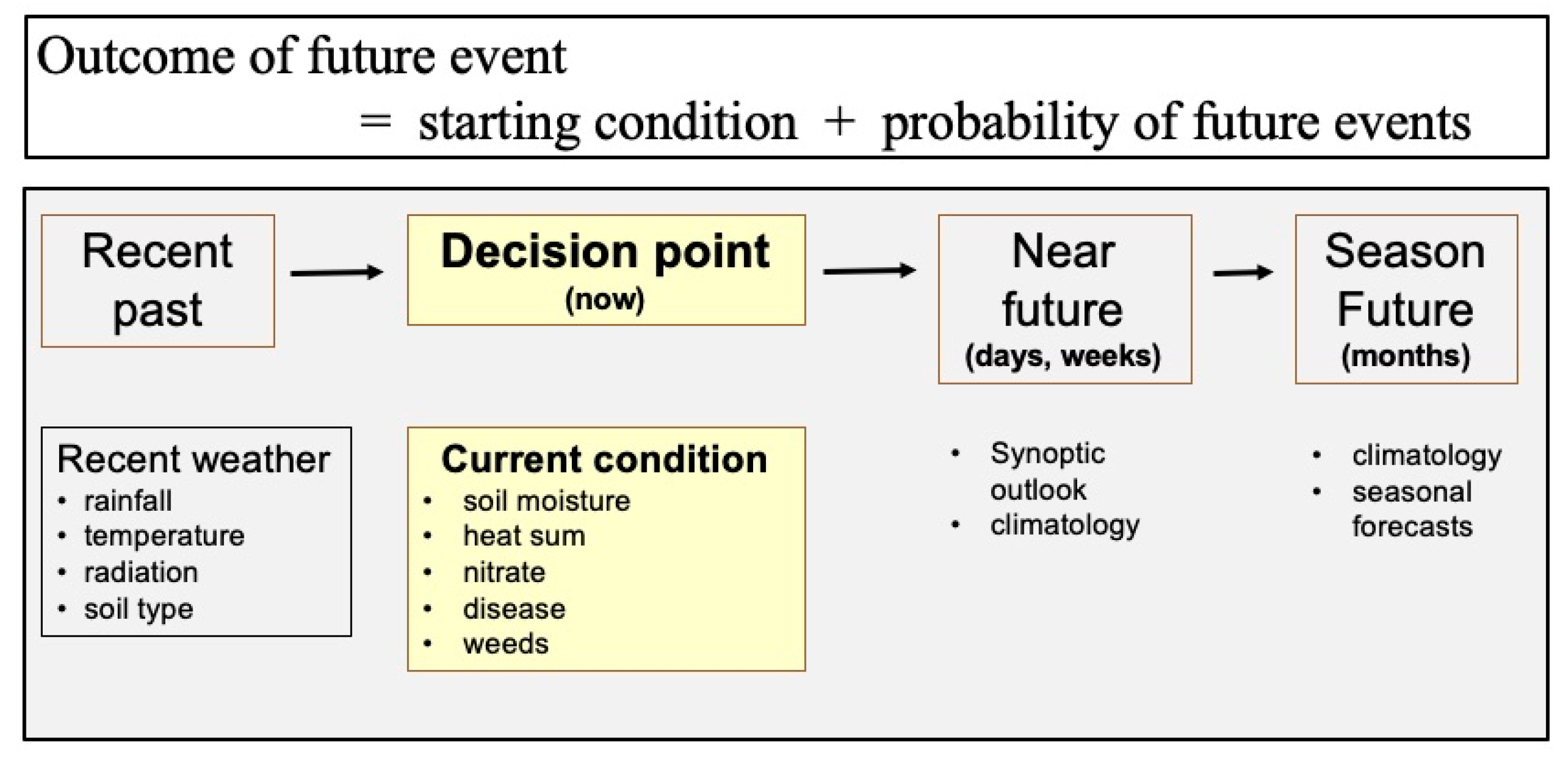
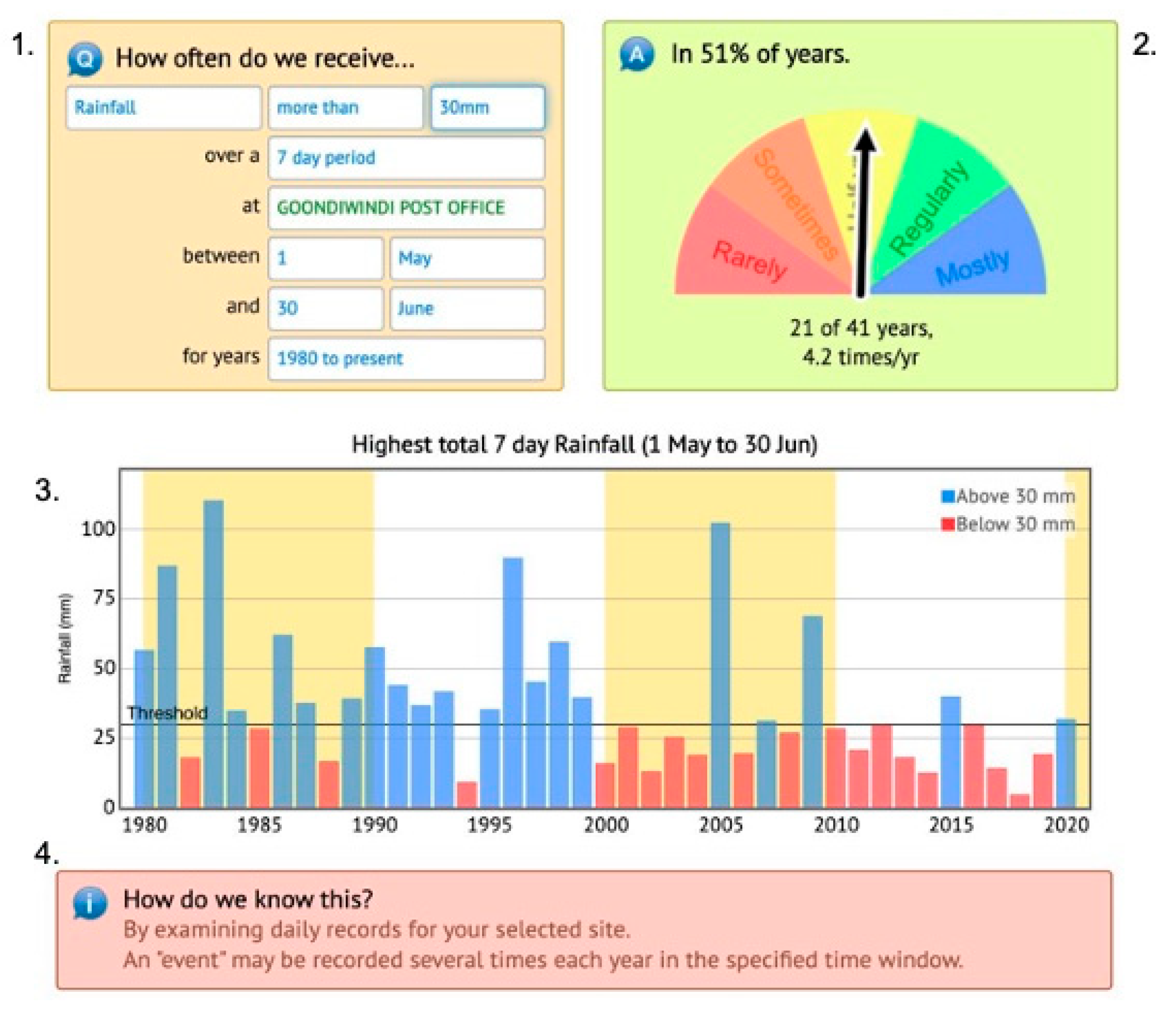
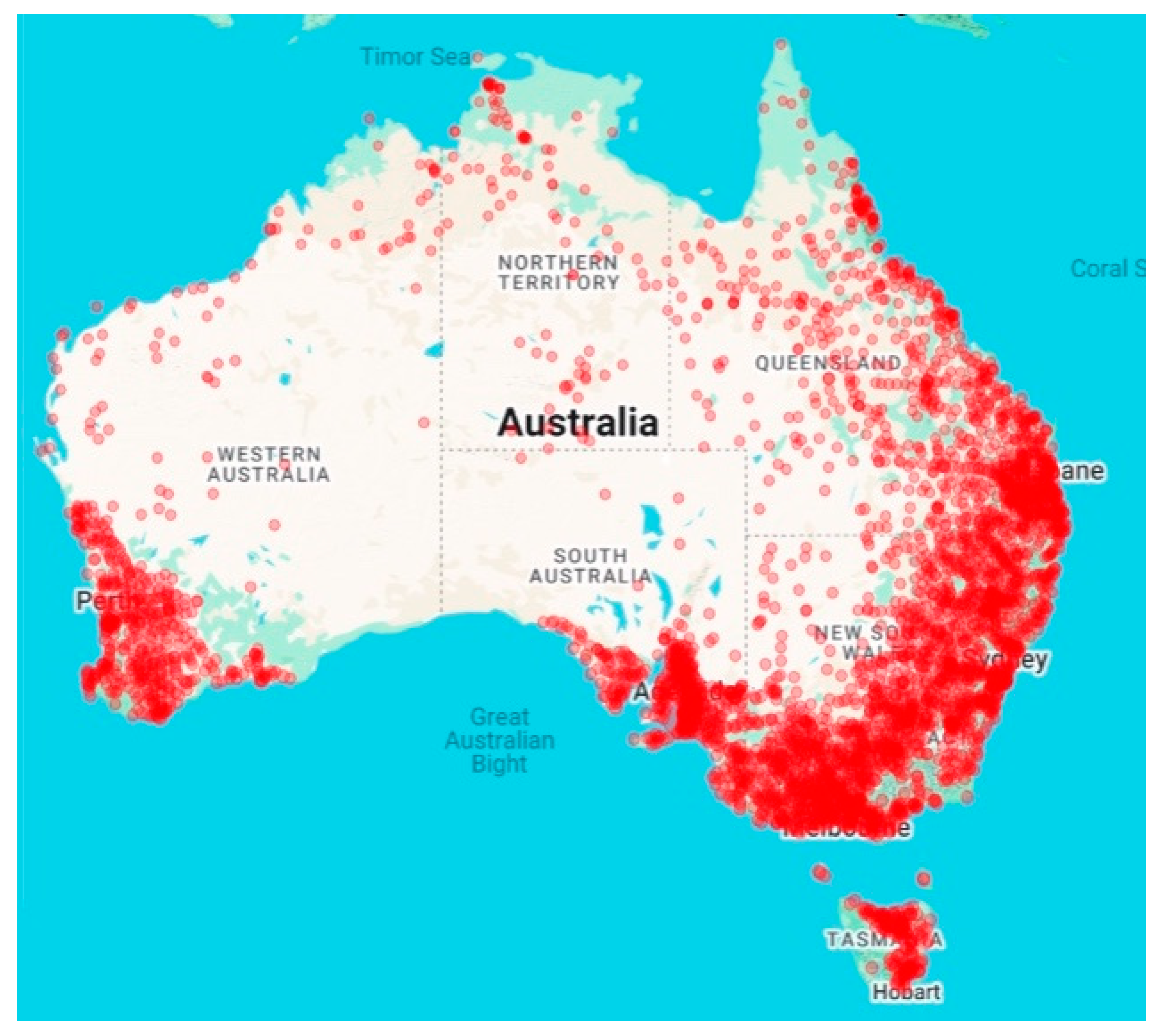

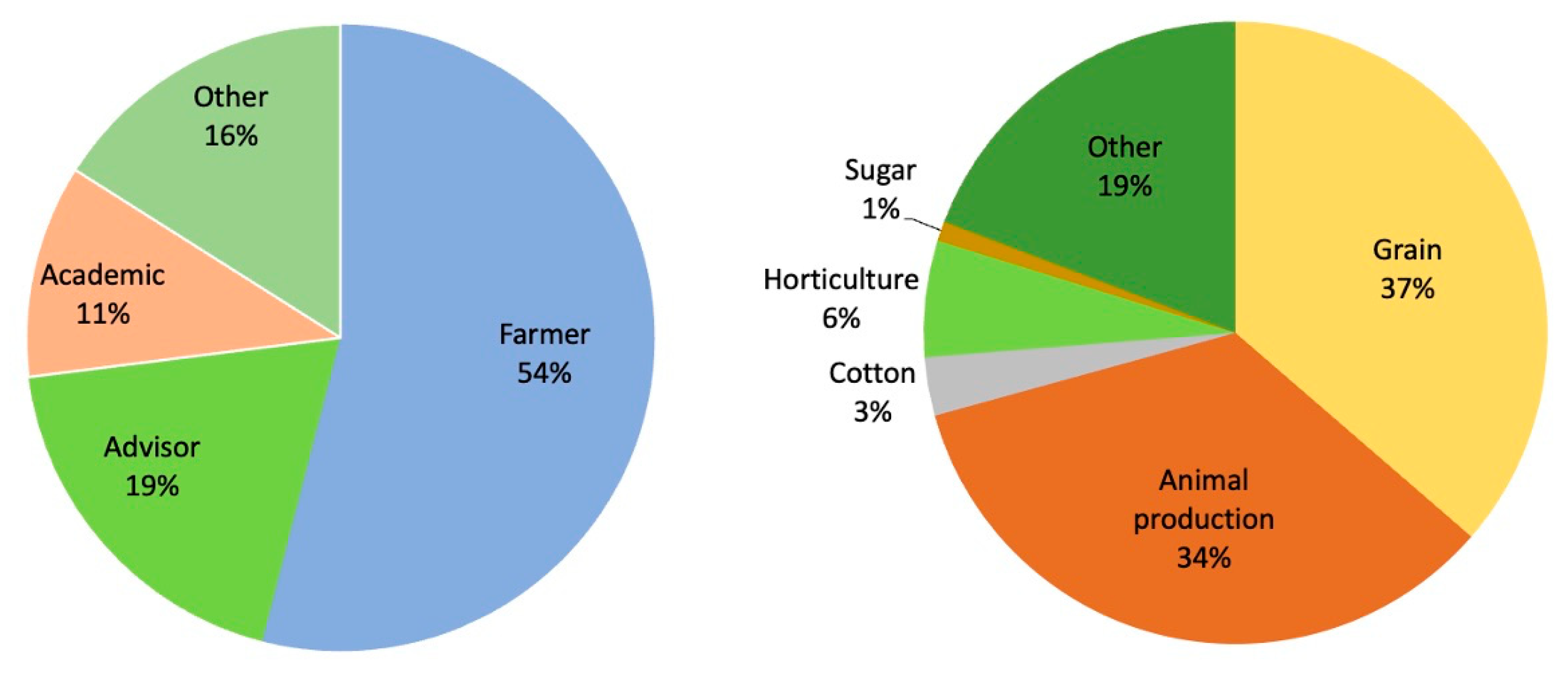
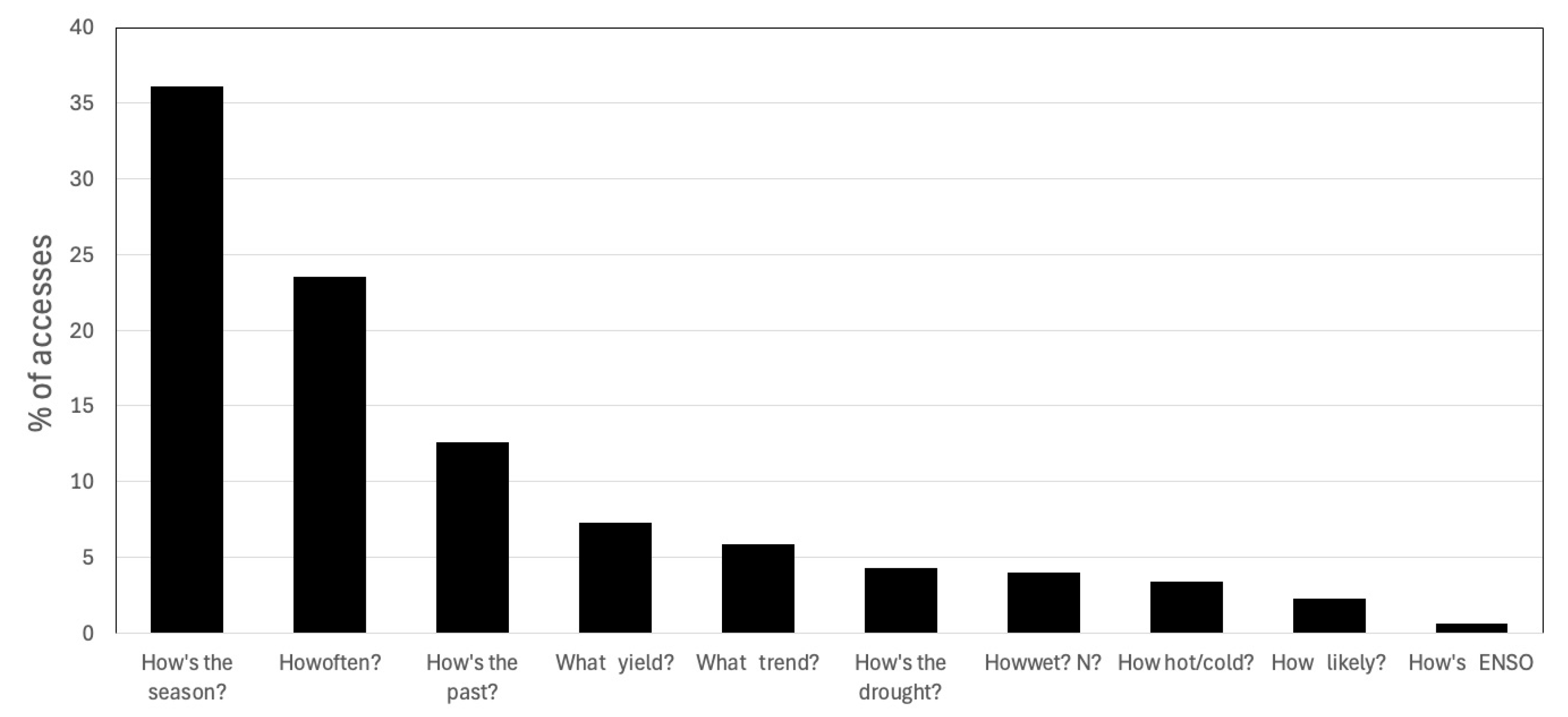
Disclaimer/Publisher’s Note: The statements, opinions and data contained in all publications are solely those of the individual author(s) and contributor(s) and not of MDPI and/or the editor(s). MDPI and/or the editor(s) disclaim responsibility for any injury to people or property resulting from any ideas, methods, instructions or products referred to in the content. |
© 2025 by the authors. Licensee MDPI, Basel, Switzerland. This article is an open access article distributed under the terms and conditions of the Creative Commons Attribution (CC BY) license (https://creativecommons.org/licenses/by/4.0/).
Share and Cite
Freebairn, D.M.; McClymont, D. Experiences in Developing a Decision Support Tool for Agricultural Decision-Makers—Australian CliMate. Climate 2025, 13, 188. https://doi.org/10.3390/cli13090188
Freebairn DM, McClymont D. Experiences in Developing a Decision Support Tool for Agricultural Decision-Makers—Australian CliMate. Climate. 2025; 13(9):188. https://doi.org/10.3390/cli13090188
Chicago/Turabian StyleFreebairn, David M., and David McClymont. 2025. "Experiences in Developing a Decision Support Tool for Agricultural Decision-Makers—Australian CliMate" Climate 13, no. 9: 188. https://doi.org/10.3390/cli13090188
APA StyleFreebairn, D. M., & McClymont, D. (2025). Experiences in Developing a Decision Support Tool for Agricultural Decision-Makers—Australian CliMate. Climate, 13(9), 188. https://doi.org/10.3390/cli13090188






